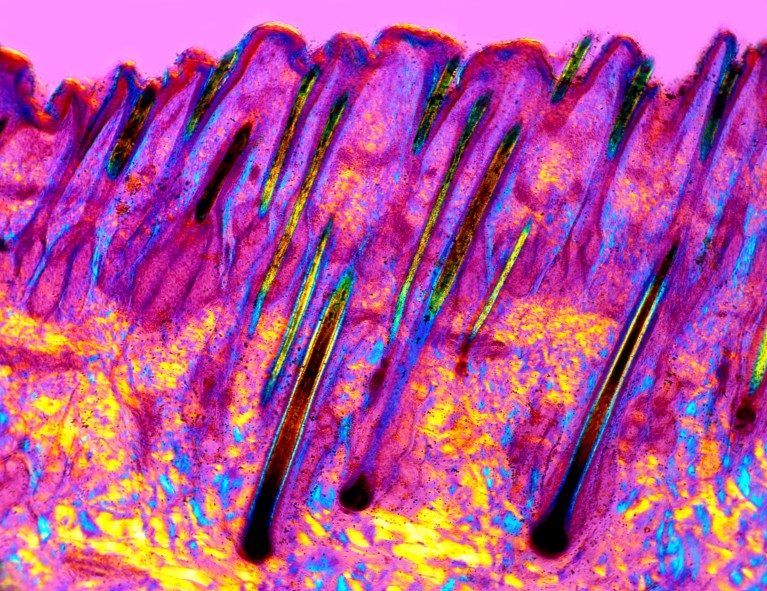Although the overhead fans hissed tirelessly, I swear I could feel it — the heat from outthere crawling through the cracks, threatening to do us all in. “Be my guest,” I dared the sliver of sun between the boarding bridge and the train. My hands itched as I rushed past business class, but when I snagged a seat, I found no rash on my palms. Not even a flush.
Of course not.
“Thank you for choosing …” the train speakers chased passengers to empty seats. If heat prickled their skin, their expressions did not betray it, although half the railcar hid behind masks. I made a game of guessing which dangers they sought to parry with polypropylene. For my part, the stench of gas — motor and human — had me reaching for my respirator.
Instead, I pulled up my hood.
“This seat taken?”
I turned to the stranger — you — with a flat frown. Coach wasn’t a place for courtesy. “Clearly it’s not.”
You grinned. “Gorge.”
As if to emphasize my incredulity, the speakers announced: “If you cannot find a seat, please wait for the next train.”
While I skimmed my e-book, you and your silver curls settled into the seat across. The black shimmer across your lids sharpened your eyes from curious to knowing. I couldn’t resign myself to your distraction so I searched my backpack for my pills.

Read more science fiction from Nature Futures
You smirked like we shared a secret.
“They’re authorized.”
“I’m sure.” When I didn’t respond to your teasing tone, you added, “Whatever it takes to reach tomorrow, right?”
“Tickets!” The conductor emerged, eyes tired, and squinted at your ID. “Damn.”
You laughed. “I know right!”
My own name inspired a similar sigh, but the speakers cut off the conductor’s wisecrack: “Thank you for choosing …”
“So wanna guess what name my parents cursed me with? I’ll give you a hint: celestial.”
My own snort surprised me. “That’d apply to me too.” I quickly added, “But I’m not one to talk to strangers.”
“Wouldn’t be strangers if we knew each other’s names.”
The hum of the train’s departure stole your attention and my medication mine. I turned up my phone’s brightness, determined to make it to the next page.
“Gorgeous,” you expanded your first abbreviation. My eyes darted up to clarify what, exactly, you were referencing. Not me — the view. Fields of sunflowers in perfect bloom.
“Almost too good to be true,” I muttered at the rows of golden-yellow.
Your gaze turned fond as if my cynicism was charming. “Is it so bad that I don’t want to see the real thing? There’s nothing we can do so I’d rather … pretend.”
“Pretend,” I repeated.
“That sounds horrible, doesn’t it?”
“No,” I said quietly. “Sounds like you’re trying to reach tomorrow.”
When you leaned forwards, I tightened my grip on my backpack — but you only pushed my hood away. “We’re safe inhere.”
Keystrokes and slow conversation filled our silence, and I wiggled on my sticky seat, trying to fold my long legs. You caught my ankles and stretched me into your space, then curled into a ball to sleep.
I managed a dozen pages and a dozen glances in your direction before the train made its first stop. “We’re having some technical issues, please remain seated.”
Five pages. Behind us, two teenagers flirted in low tones. I wondered if they thought the same of us. Ten pages. “Thank you for choosing …” Twenty pages. “We apologize for this delay. Feel free to get a ticket for the next train.” An elderly passenger scoffed, launching into a rant, while I pulled up the ticket prices on my phone.
You woke up with a pout. “What’s happening?”
“Delays. We can get on the next train though.”
“Are you?”
I sighed. “I can’t afford to.”
Five pages. An old couple told their love story to a chatty businessman. I caught your eye, by accident, and our frustrations softened. “That’s sweet.”
“Mm.”
Ten pages. Some left, many stayed. You sat awake, watching me. “Did you know that today used to be a holiday?” you made polite conversation. Only I wasn’t polite. “They called it May Day …” I worked hard not to listen.
Twenty pages. The conductor walked through the aisles, fielding questions and complaints. Every page or so, the speakers crackled, until at last: “We thank you for your patience, the journey will resume shortly.”
My mouth twisted up. The faces in the railcar were bewildered, sharing smiles of relief and irritation. You gifted me a wink, and god help me, my cheeks itched for it. This time, I didn’t blame the flush on delusions of heat.
“Aurora.”
“W — what?” I stammered.
“Your name, I’m trying to guess.”
I got one page in before you tried again. By attempt seven, the train began to slow, metal groaning beneath us. “Come on, it’s not Luna? You look like a Luna —”
The windows flickered, and all at once, sunflower fields gave way to truth. You hushed at the sight of outthere — a scorched wasteland of brittle weeds. The scattered carrion were more bones than flesh, and although the horizon blurred from heat, I could swear three figures stumbled across the ruins.
“Oh.” The breath punched out of you like a hiss. Or was that the heat at last crawling inhere? If the engine and displays had malfunctioned, could other systems in the train have failed? My hand hovered over the edges of the window as if I might wave to the three wanderers, until something — you — snatched it away.
You sat back in your seat with a squint, forcing yourself to bear witness.
“Hecate,” I whispered my name, desperate to pretend again.
But it only made the hiss louder.
“I’m Eos.”
Neither one of us knew what else to say. And when tears streaked through your black shimmer, all I could do was swipe my screen to the next page.
“Thank you for choosing …”
The story behind the story
Miranda Jensen reveals the inspiration behind Inhere, Outthere
Years ago, I took the infamous Amtrak train between Washington DC and New York City. I was wildly unprepared for the adventure: seasoned commuters sprinting to snag window seats, ceiling ventilation duelling East Coast humidity, and a series of technical difficulties that had us deboarding somewhere near Baltimore, Maryland. I was far too hangry for coherence, and yet, the circumstances only sharpened my writer’s eye. I observed my fellow passengers, eavesdropping on their small talk — and flirting — until I found myself joining in, gratefully accepting the Oreos being passed around our little section. With each delay announced over the train’s speakers, our camaraderie swelled. It was strange, I realized after the fact, how swiftly we shifted from individuals to people.
I recently experienced something similar on a train in Spain — a coincidence too strange not to write about. Particularly after the floodings that devastated Valencia, climate change was at the forefront of my mind. And so, with sunflower fields cradling me, and the chatter of Basque, Catalan and Castellano in my ears, I wrote the story’s first draft in one sitting. For a notorious outliner like me, constructing a story spontaneously was a challenge befitting the transportation anomaly.
That said, this genre is one close to my heart; my father taught me a love for science fiction before even literacy. All the stories I tell are predicated on sparking change — thus, the ambiguous, ruinous world of Hecate and Eos. It is a tale in sight of climate justice, of course, but more than that, it is a dystopian interrogation of our modern logic. Nature is but one victim of many in the dichotomy of us versus them. Of in here versus out there.





















